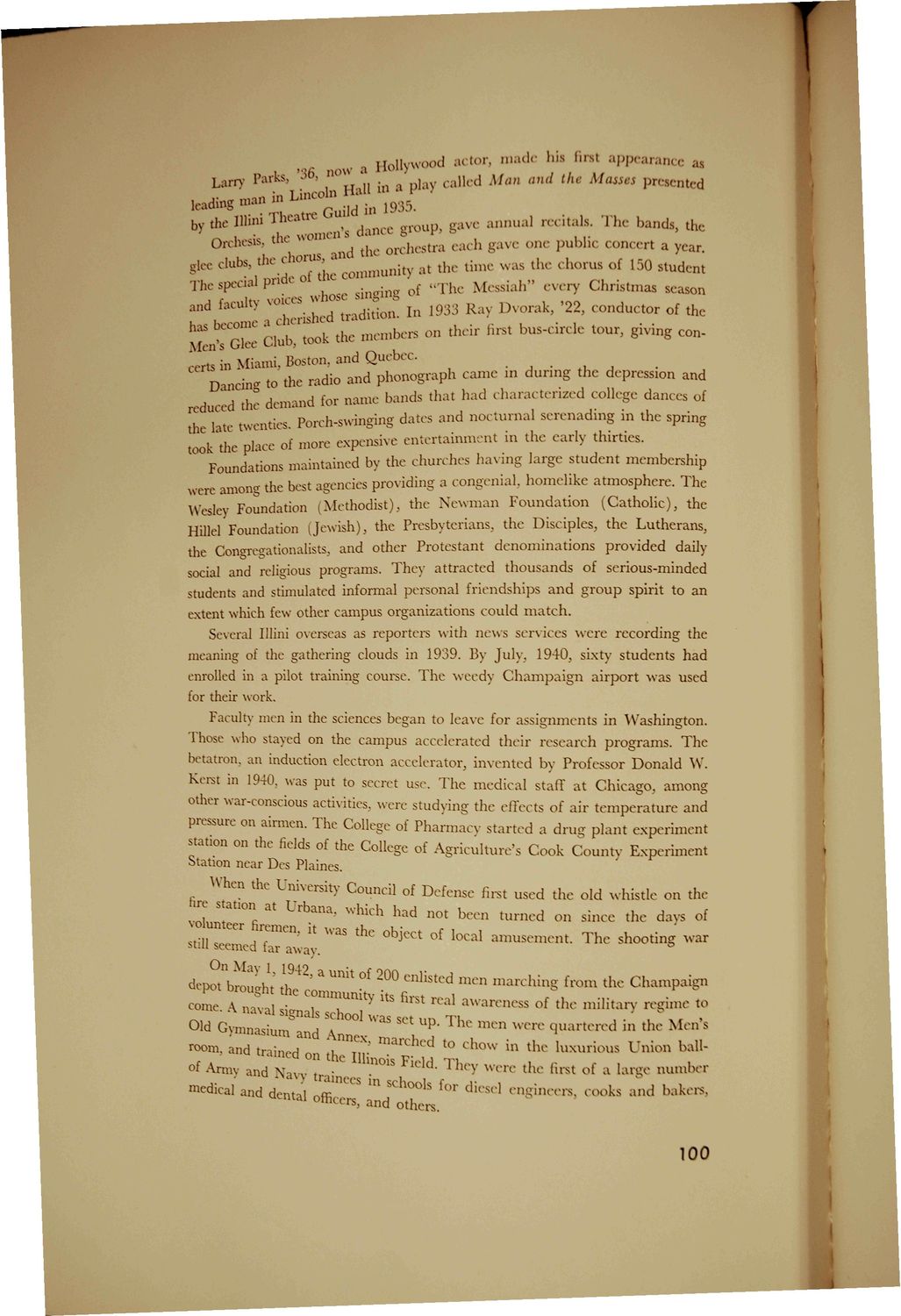| |
| |
Caption: Book - Illini Years
This is a reduced-resolution page image for fast online browsing.

EXTRACTED TEXT FROM PAGE:
Larry Parks. 36, now , Hollywood actor, made his first appearance aa ^ ^ ^ ^ ^ fl||rf ^ W a | W j prrsrntrcJ annual recitals. J he hands, th. ^ T r ^ bv the IH»" inca t • W Guild i» 1935. ' V the* \\0I1H I1S Ucuiw^ ^ r-' ^ Orchesis, tnc ^ MU glee clubs, the <* *' phe special pride : m d f UU ,V ^ orc hestra onununity rf each gave one public concert a year. a t the time was the chorus of 150 .student ^ j ^ . ^ , , ( . v r r y c l i r i s t m a s S(.ason W i s h e d tradition. In 1933 Ray Dvorak, '22, conductor of the £ J J G E ^ took the members on their first bus-circle tour, giving conc e S to Miami, Boston, and Quebec. Dancing to the radio and phonograph came ui during the depression and educed the demand for name bands that had characterized college dances of the late twenties. Porch-swinging dates and nocturnal serenading in the spring took the plaee of more expensive entertainment in the early thirties. Foundations maintained by the churches having large student membership were among the best agencies providing a congenial, homelike atmosphere. The Wesley Foundation (Methodist), the Newman Foundation (Catholic), the Hillel Foundation (Jewish), the Presbyterians, the Disciples, the Lutherans, die Congregationalists, and other Protestant denominations provided daily social and religious programs. They attracted thousands of serious-minded students and stimulated informal personal friendships and group spirit to an extent which few other campus organizations could match. Several Illini overseas as reporters with news services were recording the meaning of the gathering clouds in 1939. By July.. 1940, sixty students had Champ. for their work. Faculty men in the sciences began to leave for assignments in Washington. ose who stayed on the campus accelerated their research programs. The *.*w^ » »> OUIHU UAI uu, campus acccieratea uieir researcn programs, ine wv betatron, an induction electron accelerator, invented by Professor Donald W. Kerst in 1940. was put to secret use. The medical staff at Chicago, among other war-conscious activities, were studying the effects of air temperature and pressure on airmen. The College of Pharmacy started a drug plant experiment station on the fields of the College of Agriculture's Cook County Experiment Station near Des Plaines. otation nenr TVs P1^;„M When the University Council of Defense first used the old whistle on the hre station at Urbana, which iiad not been turned on since the days of ounteer firemen, it was the object of local amusement. The shooting war suu seemed far awav ° depot bought t h e ™ ? " ' ° ° Champaign n , t y t S firet n i l come - JZ v 1 7T ' ' — — °f <1- mffitary regime to a S S 01 W a s s c t l Th Old C v m „ V i u n ; " ' . ° 'P- >' men were quartered i.i the Men's ^om. and trained on ihe'nr " ^ ° ^ * ld VKW f Uv c °* Army and Navy traine • ° ' ^ * * '""' ° * * h h f r in, TS c o o k s a , u i medical and dental office^ ' " *' °° ° ' '''' "'' ' " ' ' ' ' l b C IUXUrioUS U n i 0 D hM 4 1 f 20 CnHstCd m e n n U u v h i n llom ,hc ' ' ~ ' RVmhCt bakcK 100
| |